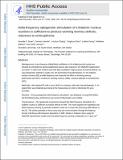| dc.contributor.author | Duan, Aranda R. | |
| dc.contributor.author | Varela, Carmen | |
| dc.contributor.author | Zhang, Yuchun | |
| dc.contributor.author | Lisman, John | |
| dc.contributor.author | Shen, Yinghua | |
| dc.contributor.author | Xiong, Lealia Li | |
| dc.contributor.author | Wilson, Matthew A | |
| dc.date.accessioned | 2017-07-07T15:10:20Z | |
| dc.date.available | 2017-07-07T15:10:20Z | |
| dc.date.issued | 2015-02 | |
| dc.identifier.issn | 0006-3223 | |
| dc.identifier.uri | http://hdl.handle.net/1721.1/110530 | |
| dc.description.abstract | Background: Low-frequency (delta/theta) oscillations in the thalamocortical system are elevated in schizophrenia during wakefulness and are also induced in the N-methyl-D-asparate receptor hypofunction rat model. To determine whether abnormal delta oscillations might produce functional deficits, we used optogenetic methods in awake rats. We illuminated channelrhodopsin-2 in the thalamic nucleus reuniens (RE) at delta frequency and measured the effect on working memory (WM) performance (the RE is involved in WM, a process affected in schizophrenia [SZ]).
Methods: We injected RE with adeno-associated virus to transduce cells with channelrhodopsin-2. An optical fiber was implanted just dorsal to the hippocampus in order to illuminate RE axon terminals.
Results: During optogenetic delta frequency stimulation, rats displayed a strong WM deficit. On the following day, performance was normal if illumination was omitted.
Conclusions: The optogenetic experiments show that delta frequency stimulation of a thalamic nucleus is sufficient to produce deficits in WM. This result supports the hypothesis that delta frequency bursting in particular thalamic nuclei has a causal role in producing WM deficits in SZ. The action potentials in these bursts may “jam” communication through the thalamus, thereby interfering with behaviors dependent on WM. Studies in thalamic slices using the N-methyl-D-asparate receptor hypofunction model show that delta frequency bursting is dependent on T-type Ca2+ channels, a result that we confirmed here in vivo. These channels, which are strongly implicated in SZ by genome-wide association studies, may thus be a therapeutic target for treatment of SZ. | en_US |
| dc.description.sponsorship | National Institutes of Health (U.S.) (Grant R01MH086518-05) | en_US |
| dc.description.sponsorship | National Institutes of Health (U.S.) (T32NS007292-28) | en_US |
| dc.description.sponsorship | National Institutes of Health (U.S.) (R01-GM104948-02) | en_US |
| dc.language.iso | en_US | |
| dc.publisher | Elsevier | en_US |
| dc.relation.isversionof | http://dx.doi.org/10.1016/j.biopsych.2015.01.020 | en_US |
| dc.rights | Creative Commons Attribution-NonCommercial-NoDerivs License | en_US |
| dc.rights.uri | http://creativecommons.org/licenses/by-nc-nd/4.0/ | en_US |
| dc.source | PMC | en_US |
| dc.title | Delta Frequency Optogenetic Stimulation of the Thalamic Nucleus Reuniens Is Sufficient to Produce Working Memory Deficits: Relevance to Schizophrenia | en_US |
| dc.type | Article | en_US |
| dc.identifier.citation | Duan, Aranda R. et al. “Delta Frequency Optogenetic Stimulation of the Thalamic Nucleus Reuniens Is Sufficient to Produce Working Memory Deficits: Relevance to Schizophrenia.” Biological Psychiatry 77.12 (2015): 1098–1107. | en_US |
| dc.contributor.department | Massachusetts Institute of Technology. Department of Brain and Cognitive Sciences | en_US |
| dc.contributor.department | Picower Institute for Learning and Memory | en_US |
| dc.contributor.mitauthor | Shen, Yinghua | |
| dc.contributor.mitauthor | Xiong, Lealia Li | |
| dc.contributor.mitauthor | Wilson, Matthew A | |
| dc.relation.journal | Biological Psychiatry | en_US |
| dc.eprint.version | Author's final manuscript | en_US |
| dc.type.uri | http://purl.org/eprint/type/JournalArticle | en_US |
| eprint.status | http://purl.org/eprint/status/PeerReviewed | en_US |
| dspace.orderedauthors | Duan, Aranda R.; Varela, Carmen; Zhang, Yuchun; Shen, Yinghua; Xiong, Lealia; Wilson, Matthew A.; Lisman, John | en_US |
| dspace.embargo.terms | N | en_US |
| dc.identifier.orcid | https://orcid.org/0000-0001-7149-3584 | |
| mit.license | PUBLISHER_CC | en_US |
